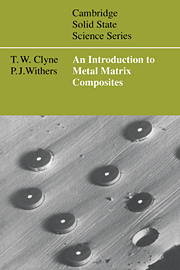Book contents
- Frontmatter
- Contents
- Preface
- 1 General introduction
- 2 Basic composite mechanics
- 3 The Eshelby approach to modelling composites
- 4 Plastic deformation
- 5 Thermal effects and high temperature behaviour
- 6 The interfacial region
- 7 Fracture processes and failure mechanisms
- 8 Transport properties and environmental performance
- 9 Fabrication processes
- 10 Development of matrix microstructure
- 11 Testing and characterisation techniques
- 12 Applications
- Appendix I Nomenclature
- Appendix II Matrices and reinforcements – selected thermophysical properties
- Appendix III The basic Eshelby S tensors
- Appendix IV Listing of a program for an Eshelby calculation
- Author index
- Subject index
7 - Fracture processes and failure mechanisms
Published online by Cambridge University Press: 04 February 2010
- Frontmatter
- Contents
- Preface
- 1 General introduction
- 2 Basic composite mechanics
- 3 The Eshelby approach to modelling composites
- 4 Plastic deformation
- 5 Thermal effects and high temperature behaviour
- 6 The interfacial region
- 7 Fracture processes and failure mechanisms
- 8 Transport properties and environmental performance
- 9 Fabrication processes
- 10 Development of matrix microstructure
- 11 Testing and characterisation techniques
- 12 Applications
- Appendix I Nomenclature
- Appendix II Matrices and reinforcements – selected thermophysical properties
- Appendix III The basic Eshelby S tensors
- Appendix IV Listing of a program for an Eshelby calculation
- Author index
- Subject index
Summary
In earlier chapters, the mechanics of elastic and plastic deformation has been treated through an evaluation of the average stresses in each phase. Unfortunately, this is not an adequate basis for the treatment of fracture and failure, which depend on the local processes controlling the initiation and propagation of a crack. Great sensitivity is thus expected to local parameters such as the reinforcement distribution, morphology and size, as well as to interfacial strength. These factors can vary considerably, often in a poorly controlled manner, and this has led to apparently contradictory experimental data. In this chapter, long fibre composites are considered first. These materials have low ductilities, because of the constraint imposed by the fibres, and simple treatments developed for polymer-based composites can be used to predict the failure stress. The situation is less simple for discontinuous reinforcement, for which the stress state is complex and there is considerable scope for plastic flow. In order to gain an insight into the influence of composite microstructure on failure, aspects of damage initiation and propagation are first examined through a consideration of simple models. While some useful predictions can be made, theoretical treatments in this area cannot yet be regarded as mature.
Failure processes in long fibre MMCs
Failure of laminae
Under an arbitrary stress state, a lamina (a sheet containing unidirectionally aligned long fibres) can fail in one of three ways, as depicted in Fig. 7.1.
- Type
- Chapter
- Information
- An Introduction to Metal Matrix Composites , pp. 218 - 276Publisher: Cambridge University PressPrint publication year: 1993
- 1
- Cited by

